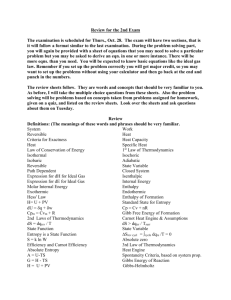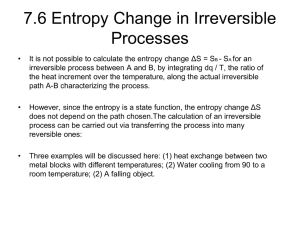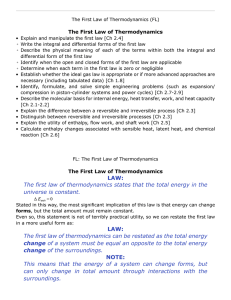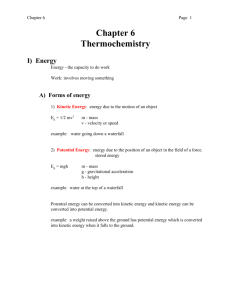Review for Exam 1 - Idaho State University
advertisement
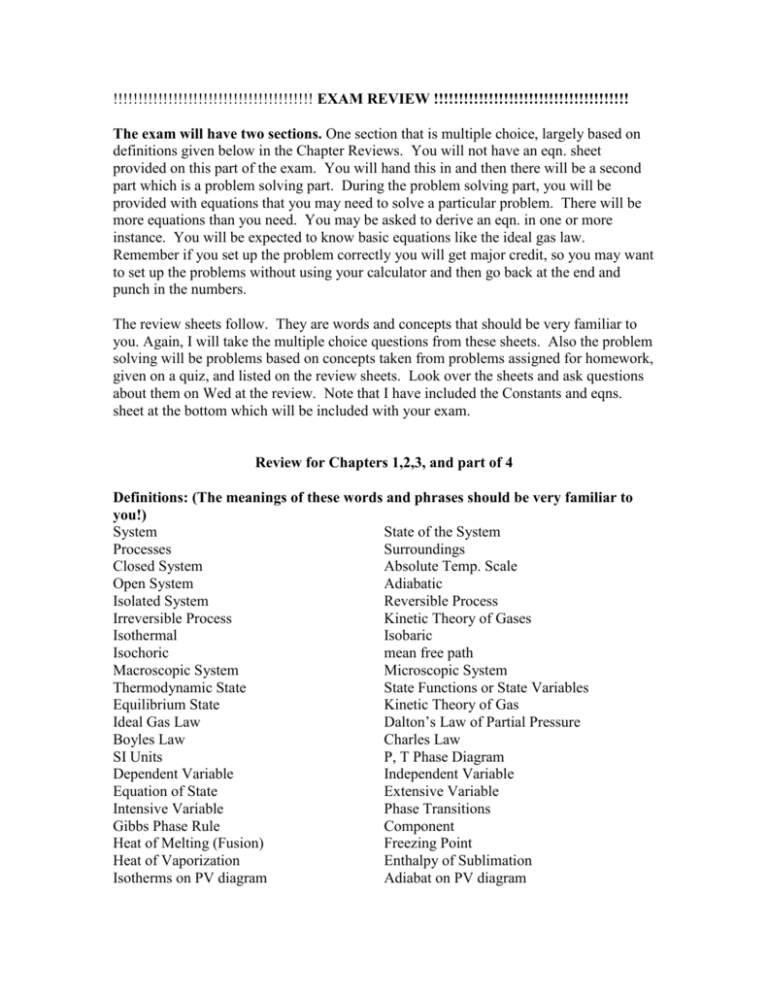
!!!!!!!!!!!!!!!!!!!!!!!!!!!!!!!!!!!!!!!! EXAM REVIEW !!!!!!!!!!!!!!!!!!!!!!!!!!!!!!!!!!!!!!! The exam will have two sections. One section that is multiple choice, largely based on definitions given below in the Chapter Reviews. You will not have an eqn. sheet provided on this part of the exam. You will hand this in and then there will be a second part which is a problem solving part. During the problem solving part, you will be provided with equations that you may need to solve a particular problem. There will be more equations than you need. You may be asked to derive an eqn. in one or more instance. You will be expected to know basic equations like the ideal gas law. Remember if you set up the problem correctly you will get major credit, so you may want to set up the problems without using your calculator and then go back at the end and punch in the numbers. The review sheets follow. They are words and concepts that should be very familiar to you. Again, I will take the multiple choice questions from these sheets. Also the problem solving will be problems based on concepts taken from problems assigned for homework, given on a quiz, and listed on the review sheets. Look over the sheets and ask questions about them on Wed at the review. Note that I have included the Constants and eqns. sheet at the bottom which will be included with your exam. Review for Chapters 1,2,3, and part of 4 Definitions: (The meanings of these words and phrases should be very familiar to you!) System State of the System Processes Surroundings Closed System Absolute Temp. Scale Open System Adiabatic Isolated System Reversible Process Irreversible Process Kinetic Theory of Gases Isothermal Isobaric Isochoric mean free path Macroscopic System Microscopic System Thermodynamic State State Functions or State Variables Equilibrium State Kinetic Theory of Gas Ideal Gas Law Dalton’s Law of Partial Pressure Boyles Law Charles Law SI Units P, T Phase Diagram Dependent Variable Independent Variable Equation of State Extensive Variable Intensive Variable Phase Transitions Gibbs Phase Rule Component Heat of Melting (Fusion) Freezing Point Heat of Vaporization Enthalpy of Sublimation Isotherms on PV diagram Adiabat on PV diagram Kinetic Energy 1st Law of Thermodynamics Probability Distribution Maxwell-Boltzmann Distribution Van der Waals Eqn of State Work Heat Hess’ Law Effusion Grahams Law of Effusion Constant Pressure Heat Capacity Endothermic Thermochemical Eqn. Combustion Molar Internal Energy Root Mean square speed H = U+ PV Ideal Monatomic Gas Cvm = 3/2R Path Dependent Expression for dH for Ideal Gas Molar Internal Energy Hess' Law H= U + PV Cp = Cv + nR 2nd Laws of Thermodynamics Heat Engine Potential Energy Internal Energy Momentum, Pressure Average Speed of a Gas (how can you get it) Virial Eqn. Compressibility Factor External Pressure Adiabatic Diffusion Bomb Calorimeter Constant Volume Heat Capacity Exothermic Heat of Formation, Enthalpy of Formation Average Bond Energies Collision Frequency Kirchoff's Law Ideal Monatomic Gas Cpm = 5/2 R Isenthalpic Closed System Expression for dU for Ideal Gas Enthalpy Enthalpy of Formation dU = q + w Cpm = Cvm + R Carnot Heat Engine Calculations: You should be familiar with the following types of Calculations Using the Ideal Gas Law, or a form of it such as Boyles or Charles’ Law to Solve for P,V, T, or n, Use of nonideal eqns. such as virial eqn. or compressibility factor Use of Grahams law of effusion, calculating average or rms speed, mean free path Expressing U in terms of Heat and Work, Use of the 1st Law of Thermodynamics Use and/or derivation of Expressions for Internal Energy, Work, Heat, Enthalpy of different types of processes such as reversible, isothermal, adiabatic, isobaric, isochoric from the basic definitions Use of the Gibbs Phase Rule Dependence of Enthalpy on Temperature Use of Heat Capacity to determine enthalpy or internal energy changes Calculation of H and U for a chemical reaction from heats of formation, heats of combustions, bond enthalpies, or a more general use of Hess’s Law Calculation of H or U at an elevated temperature (Kirchoff's Law) Expressions for dH and dU for an ideal gas Converting between H and U Finding H for phase changes or heating a material that not only is heated, but goes through phase changes Use of the concept of a State Function in calculations From Chp 4 General statements that define natural processes talk about the observed efficiencies in converting heat into work, the direction of heat flow, and the fact that the disorder of the universe seems to be increasing. These can be formulated into a mathematical statement of spontaneity which involves the entropy. In any irreversible process the entropy of the universe increases. Because entropy is a state variable, the entropy change of the system can be calculated using a reversible process having the same initial and final states as the irreversible process. In any reversible process the entropy of the universe remains constant and therefore this constitutes the minimal or maximal work case. The Carnot efficiency tells about the maximum efficiency realizable for a process which converts heat to work. The expression for the Second Law of Thermodynamics Stot > 0 for an irreversible process is strictly applicable to the system and the surroundings. REMEBER that if you do your calculation using SI units, your answer will also be in SI units. Units are your friend. Constants and Equations PV = nRT, Vi/Ti = Vf/Tf, Z1 = 1 / 2 d2 cav(N/V) PiVi = PfVf, Etrans = n 3/2 RT (P+(an2 /V2 ) (V-nb)=nRT Pi/Ti = Pf/ Tf f(c) = 4c2 (m/2kT)3 / 2 exp(-mc2 /2kT) Z1 = 1 / 2 d2 cav(PNav/RT) Z11 = (2)½ /2 d2 cav(PNav/RT) = cav/z1 c = (3RT/Mm)1 / 2 c =(2RT/Mm)1 / 2 c = (8RT/(m))1 / 2 F = ma F = -kx PE=mgh KE = ½ mv2 U = Q + W, W = -Pext V, W= F dl W= - P dV, W = -nRT ln(Vf/Vi) F= C-P+2 W = nRT ln(Pf/Pi) Q = n C Q = m C dU = Cv dT, dH = Cp dT, H=U +PV, Qp, U = Qv, c = Cvm /R, Tf/Ti = (Vi/Vf)1/c (PiVi)g = (PfVf)g, H = U + ngRT g = Cpm/Cvm, H = U + (PV) Hrxno(T2) = Hrxno(T1) + T rCpo dT rxno = prod n Hfo - react n Hfo S = nR ln(Vf/Vi) S=-nR ln(Pf/Pi) = 1- Tc/Th Cpm = R + Cvm K = oC + 273.15 1atm = 101325 Pa 1 atm = 14.7 psi 1atm = 101325 Pa 1 bar = 105 Pa g = 9.81 m/s2 R= 0.08206(Latm)/(mol K) 1L = 0.001 m3 R=8.314J/mol K g=9.81m/s2 1cm3 = 1mL






